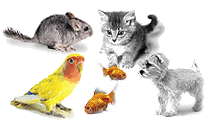posted 05-18-2003 01:15 AM


A commonly believed piece of canine folklore is that a healthy dog is one whose nose is cold and wet. The origin of this gauge of health is unknown. Nor is it know how a cold nose could tell if an animal had any type of intestinal worms, hereditary birth defects of the heart, cranium, blindness or deafness. The sad fact is that even with the education materials readily available from veterinarians, pet stores, books and the Internet, many people still hold to this belief.
Healthy dogs require responsible owners who will see to their nutritional needs and proper preventative, veterinary care. A cheap, low quality dog food will never give the results of full, shiny coats or small, firm stools.
There are many signs of a healthy dog and the following are a starting point in your search.
1. Coat - The coat should be full, shiny and soft to the touch. Wire coats should be springy and full of life. There should be no thinning or lack of undercoat in double coated breeds such as the Collie and German Shepherd.
2.Skin – The skin should be smooth without areas of redness, open sores, scales, scabs or growths. Normal skin pigment can vary according to the breed and color of the dog. Some will have pink, black, brown or even spotted areas to the skin. The dog should be free of fleas, ticks and other external parasites.
3.Eyes – The eyes of a healthy dog are shiny and bright. The area around the eyeball is known as the conjunctiva and should appear a healthy pink. Paleness in this area could be a sign if several underlying problems. There should be no thick, green or yellow discharge from the eyes. Certain breeds such as Poodles or Bichons tend to have a “watery” discharge that can often be considered normal.
4.Ears – Ears should be clean with no dark or bloody discharge or matter in the canal. Nor should there be any foul odor emanating from the ear, redness, or swelling.
5.Mouth – Gums should be pink or pigmented with black. Paleness in the gums can be a sign of anemia. Red, inflamed gums are often a sign of gingivitis or other periodontal disease. The dog should have no bleeding or foul breath.
6.Teeth – Young dogs will have sparkling white teeth where as older dogs will have a darkening to theirs. This darkening should not include any hard white, yellow, green or brown matter. The teeth should also fit into the gum with none of the root supply showing.
7.Nose - It is true a dog’s nose is normally moist and cold to the touch. The moistness should be only from clear, watery secretions. Any yellow, green or foul smelling discharge is abnormal. These discharges can often be a signal of canine distemper in younger dogs.
8.Temperature – The normal temperature of a dog is 101 degrees F when checked rectally with a thermometer. Excited dogs or those who have been exercising may run a slightly higher temperature but drastic increases of over 103 degrees or decreases registering as less than 100 degrees should be checked out. There is one exception to this rule. Female dogs that are about to give birth will often have a temperature that drops to 99 degrees. This can occur as far as twenty-four hours before the actual birth begins.
9.Urine – Urine should be clear and yellow. Dark brownish or reddish color to the urine usually means the presence of blood. A dog should also urinate in proportion to the amount of water taken in. Drastic increases or decreases can signal such things as kidney failure, stones, crystals or even diabetes.
10.Feces – A dog’s feces should be firm and brown. This color can be affected by the brand of dog food you use. Those that use a high amount of red food color will have stools that are almost brick color. There should be no worms, “grains of rice”, red blood or black color in the stool. An owner also needs to be aware of any diarrhea, constipation, or even total lack of fecal production.
11.Muscles – An owner should be able to feel the indentations of the muscles. There should be no odd lumps in the tissue.
12.Weight – A dog that appears healthy in every way may still be over or underweight. The rib, back and hipbones should not show but be able to be palpated or felt. Dogs may have weight problems due to inadequate or over abundance of diet, diabetes, thyroid and various other problems.
These are just a few guidelines that you can look for in your pet. A qualified veterinarian is the best source of information concerning your dog’s health and will often offer tips that are geared specifically towards your dog’s breed and age.
Many breeds are predisposed towards certain conditions and problems. Before you purchase a new dog, it is best that you research the breed before making your final choice. Owners have often bought the “puppy in the window” only to find they have purchased a lifelong ticket to the veterinarian’s office for allergies, thyroid and structural problems as well as many others.


 Auspet - Message Boards
Auspet - Message Boards

 Articles - Dog Care & Health
Articles - Dog Care & Health

 Basic care - Signs of a healthy dog
Basic care - Signs of a healthy dog






